Benchmark - Synthesis: Research Gap in Software Development Life Cycle
VerifiedAdded on 2023/06/11
|9
|1852
|203
Literature Review
AI Summary
This literature review synthesizes several articles focusing on the Software Development Life Cycle (SDLC), common findings, and research gaps. The review highlights the importance of technology selection, project management, and the challenges faced by private sectors in software development. It addresses the need for efficient software effort estimation models and the implementation of management procedures to mitigate negative impacts on development processes. The articles collectively emphasize the significance of accurate effort estimation in software projects and the potential consequences of inaccurate estimations, such as faulty software and project delays. The review identifies gaps in the literature, including the need for proper descriptions and addressing constraints in public versus private sector software development, concluding that solving SDLC-related problems requires feasible and well-implemented strategies. Desklib provides students with access to similar solved assignments and study tools.
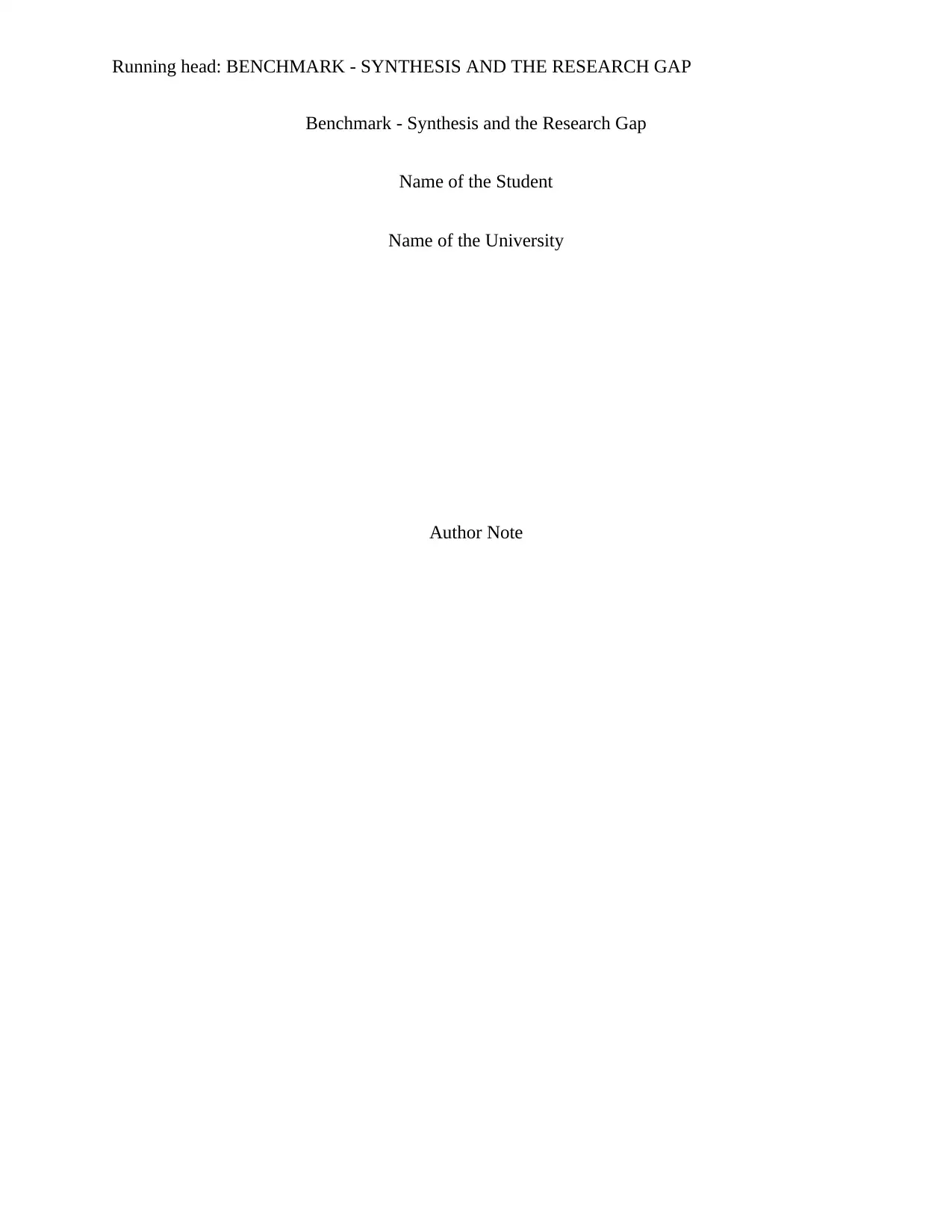
Running head: BENCHMARK - SYNTHESIS AND THE RESEARCH GAP
Benchmark - Synthesis and the Research Gap
Name of the Student
Name of the University
Author Note
Benchmark - Synthesis and the Research Gap
Name of the Student
Name of the University
Author Note
Paraphrase This Document
Need a fresh take? Get an instant paraphrase of this document with our AI Paraphraser
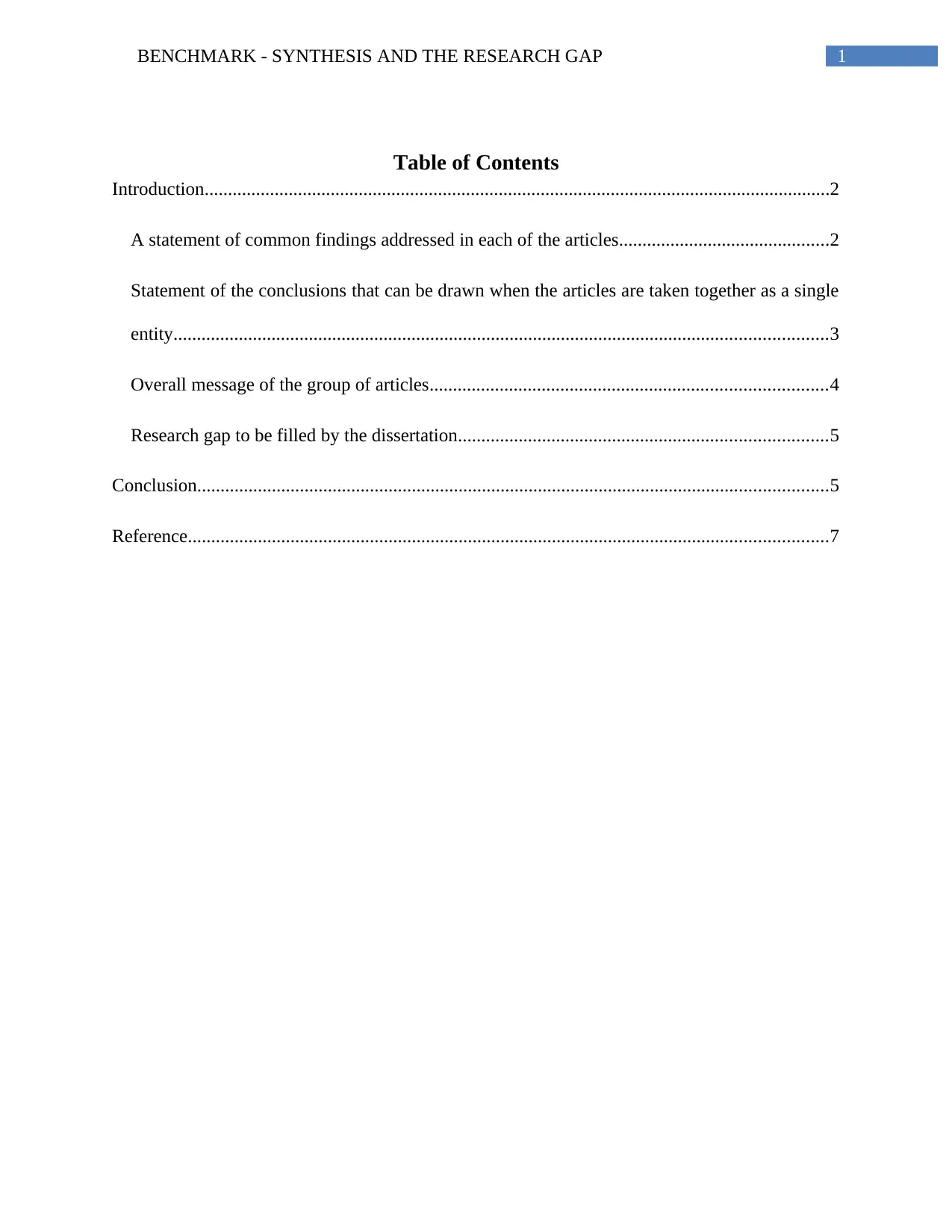
1BENCHMARK - SYNTHESIS AND THE RESEARCH GAP
Table of Contents
Introduction......................................................................................................................................2
A statement of common findings addressed in each of the articles.............................................2
Statement of the conclusions that can be drawn when the articles are taken together as a single
entity............................................................................................................................................3
Overall message of the group of articles.....................................................................................4
Research gap to be filled by the dissertation...............................................................................5
Conclusion.......................................................................................................................................5
Reference.........................................................................................................................................7
Table of Contents
Introduction......................................................................................................................................2
A statement of common findings addressed in each of the articles.............................................2
Statement of the conclusions that can be drawn when the articles are taken together as a single
entity............................................................................................................................................3
Overall message of the group of articles.....................................................................................4
Research gap to be filled by the dissertation...............................................................................5
Conclusion.......................................................................................................................................5
Reference.........................................................................................................................................7
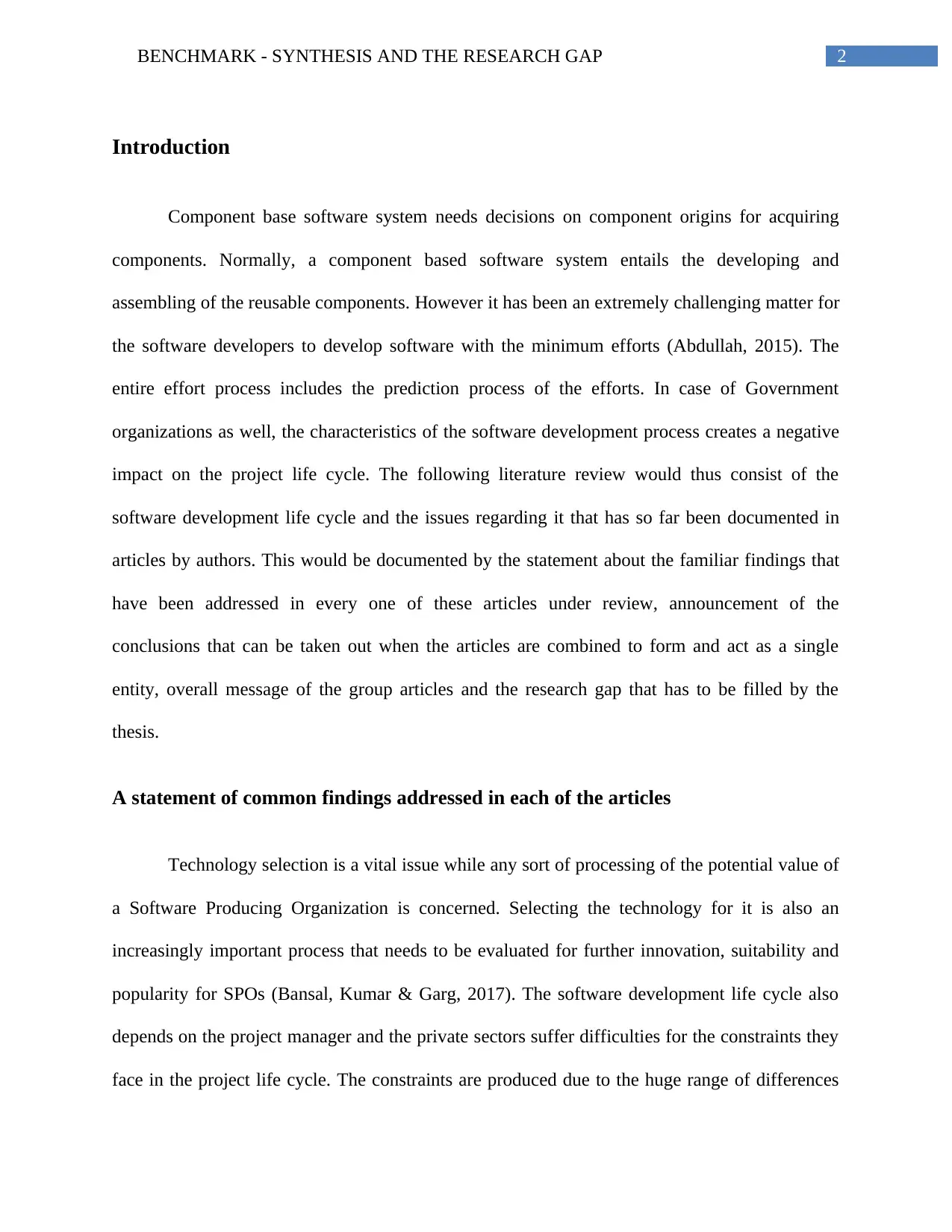
2BENCHMARK - SYNTHESIS AND THE RESEARCH GAP
Introduction
Component base software system needs decisions on component origins for acquiring
components. Normally, a component based software system entails the developing and
assembling of the reusable components. However it has been an extremely challenging matter for
the software developers to develop software with the minimum efforts (Abdullah, 2015). The
entire effort process includes the prediction process of the efforts. In case of Government
organizations as well, the characteristics of the software development process creates a negative
impact on the project life cycle. The following literature review would thus consist of the
software development life cycle and the issues regarding it that has so far been documented in
articles by authors. This would be documented by the statement about the familiar findings that
have been addressed in every one of these articles under review, announcement of the
conclusions that can be taken out when the articles are combined to form and act as a single
entity, overall message of the group articles and the research gap that has to be filled by the
thesis.
A statement of common findings addressed in each of the articles
Technology selection is a vital issue while any sort of processing of the potential value of
a Software Producing Organization is concerned. Selecting the technology for it is also an
increasingly important process that needs to be evaluated for further innovation, suitability and
popularity for SPOs (Bansal, Kumar & Garg, 2017). The software development life cycle also
depends on the project manager and the private sectors suffer difficulties for the constraints they
face in the project life cycle. The constraints are produced due to the huge range of differences
Introduction
Component base software system needs decisions on component origins for acquiring
components. Normally, a component based software system entails the developing and
assembling of the reusable components. However it has been an extremely challenging matter for
the software developers to develop software with the minimum efforts (Abdullah, 2015). The
entire effort process includes the prediction process of the efforts. In case of Government
organizations as well, the characteristics of the software development process creates a negative
impact on the project life cycle. The following literature review would thus consist of the
software development life cycle and the issues regarding it that has so far been documented in
articles by authors. This would be documented by the statement about the familiar findings that
have been addressed in every one of these articles under review, announcement of the
conclusions that can be taken out when the articles are combined to form and act as a single
entity, overall message of the group articles and the research gap that has to be filled by the
thesis.
A statement of common findings addressed in each of the articles
Technology selection is a vital issue while any sort of processing of the potential value of
a Software Producing Organization is concerned. Selecting the technology for it is also an
increasingly important process that needs to be evaluated for further innovation, suitability and
popularity for SPOs (Bansal, Kumar & Garg, 2017). The software development life cycle also
depends on the project manager and the private sectors suffer difficulties for the constraints they
face in the project life cycle. The constraints are produced due to the huge range of differences
⊘ This is a preview!⊘
Do you want full access?
Subscribe today to unlock all pages.

Trusted by 1+ million students worldwide
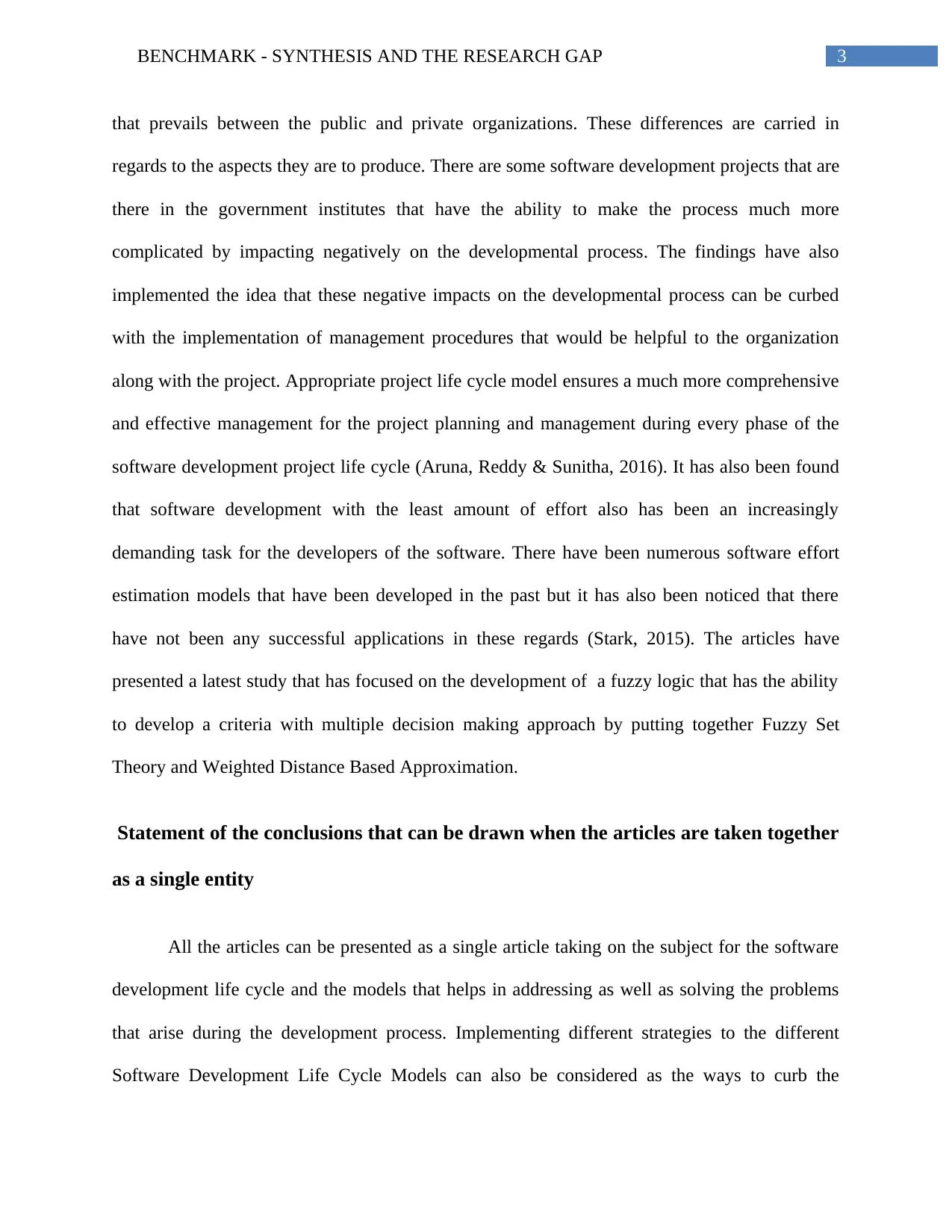
3BENCHMARK - SYNTHESIS AND THE RESEARCH GAP
that prevails between the public and private organizations. These differences are carried in
regards to the aspects they are to produce. There are some software development projects that are
there in the government institutes that have the ability to make the process much more
complicated by impacting negatively on the developmental process. The findings have also
implemented the idea that these negative impacts on the developmental process can be curbed
with the implementation of management procedures that would be helpful to the organization
along with the project. Appropriate project life cycle model ensures a much more comprehensive
and effective management for the project planning and management during every phase of the
software development project life cycle (Aruna, Reddy & Sunitha, 2016). It has also been found
that software development with the least amount of effort also has been an increasingly
demanding task for the developers of the software. There have been numerous software effort
estimation models that have been developed in the past but it has also been noticed that there
have not been any successful applications in these regards (Stark, 2015). The articles have
presented a latest study that has focused on the development of a fuzzy logic that has the ability
to develop a criteria with multiple decision making approach by putting together Fuzzy Set
Theory and Weighted Distance Based Approximation.
Statement of the conclusions that can be drawn when the articles are taken together
as a single entity
All the articles can be presented as a single article taking on the subject for the software
development life cycle and the models that helps in addressing as well as solving the problems
that arise during the development process. Implementing different strategies to the different
Software Development Life Cycle Models can also be considered as the ways to curb the
that prevails between the public and private organizations. These differences are carried in
regards to the aspects they are to produce. There are some software development projects that are
there in the government institutes that have the ability to make the process much more
complicated by impacting negatively on the developmental process. The findings have also
implemented the idea that these negative impacts on the developmental process can be curbed
with the implementation of management procedures that would be helpful to the organization
along with the project. Appropriate project life cycle model ensures a much more comprehensive
and effective management for the project planning and management during every phase of the
software development project life cycle (Aruna, Reddy & Sunitha, 2016). It has also been found
that software development with the least amount of effort also has been an increasingly
demanding task for the developers of the software. There have been numerous software effort
estimation models that have been developed in the past but it has also been noticed that there
have not been any successful applications in these regards (Stark, 2015). The articles have
presented a latest study that has focused on the development of a fuzzy logic that has the ability
to develop a criteria with multiple decision making approach by putting together Fuzzy Set
Theory and Weighted Distance Based Approximation.
Statement of the conclusions that can be drawn when the articles are taken together
as a single entity
All the articles can be presented as a single article taking on the subject for the software
development life cycle and the models that helps in addressing as well as solving the problems
that arise during the development process. Implementing different strategies to the different
Software Development Life Cycle Models can also be considered as the ways to curb the
Paraphrase This Document
Need a fresh take? Get an instant paraphrase of this document with our AI Paraphraser
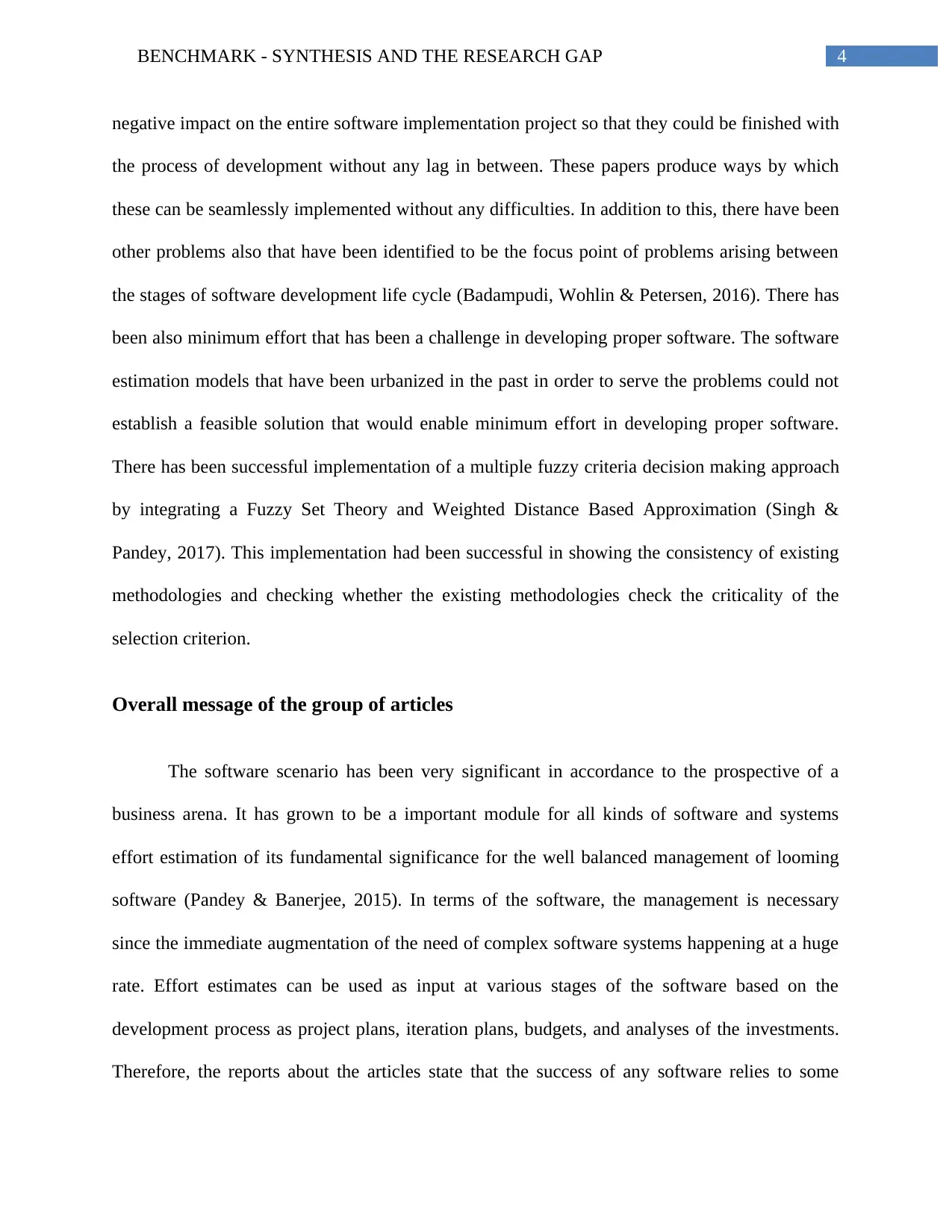
4BENCHMARK - SYNTHESIS AND THE RESEARCH GAP
negative impact on the entire software implementation project so that they could be finished with
the process of development without any lag in between. These papers produce ways by which
these can be seamlessly implemented without any difficulties. In addition to this, there have been
other problems also that have been identified to be the focus point of problems arising between
the stages of software development life cycle (Badampudi, Wohlin & Petersen, 2016). There has
been also minimum effort that has been a challenge in developing proper software. The software
estimation models that have been urbanized in the past in order to serve the problems could not
establish a feasible solution that would enable minimum effort in developing proper software.
There has been successful implementation of a multiple fuzzy criteria decision making approach
by integrating a Fuzzy Set Theory and Weighted Distance Based Approximation (Singh &
Pandey, 2017). This implementation had been successful in showing the consistency of existing
methodologies and checking whether the existing methodologies check the criticality of the
selection criterion.
Overall message of the group of articles
The software scenario has been very significant in accordance to the prospective of a
business arena. It has grown to be a important module for all kinds of software and systems
effort estimation of its fundamental significance for the well balanced management of looming
software (Pandey & Banerjee, 2015). In terms of the software, the management is necessary
since the immediate augmentation of the need of complex software systems happening at a huge
rate. Effort estimates can be used as input at various stages of the software based on the
development process as project plans, iteration plans, budgets, and analyses of the investments.
Therefore, the reports about the articles state that the success of any software relies to some
negative impact on the entire software implementation project so that they could be finished with
the process of development without any lag in between. These papers produce ways by which
these can be seamlessly implemented without any difficulties. In addition to this, there have been
other problems also that have been identified to be the focus point of problems arising between
the stages of software development life cycle (Badampudi, Wohlin & Petersen, 2016). There has
been also minimum effort that has been a challenge in developing proper software. The software
estimation models that have been urbanized in the past in order to serve the problems could not
establish a feasible solution that would enable minimum effort in developing proper software.
There has been successful implementation of a multiple fuzzy criteria decision making approach
by integrating a Fuzzy Set Theory and Weighted Distance Based Approximation (Singh &
Pandey, 2017). This implementation had been successful in showing the consistency of existing
methodologies and checking whether the existing methodologies check the criticality of the
selection criterion.
Overall message of the group of articles
The software scenario has been very significant in accordance to the prospective of a
business arena. It has grown to be a important module for all kinds of software and systems
effort estimation of its fundamental significance for the well balanced management of looming
software (Pandey & Banerjee, 2015). In terms of the software, the management is necessary
since the immediate augmentation of the need of complex software systems happening at a huge
rate. Effort estimates can be used as input at various stages of the software based on the
development process as project plans, iteration plans, budgets, and analyses of the investments.
Therefore, the reports about the articles state that the success of any software relies to some
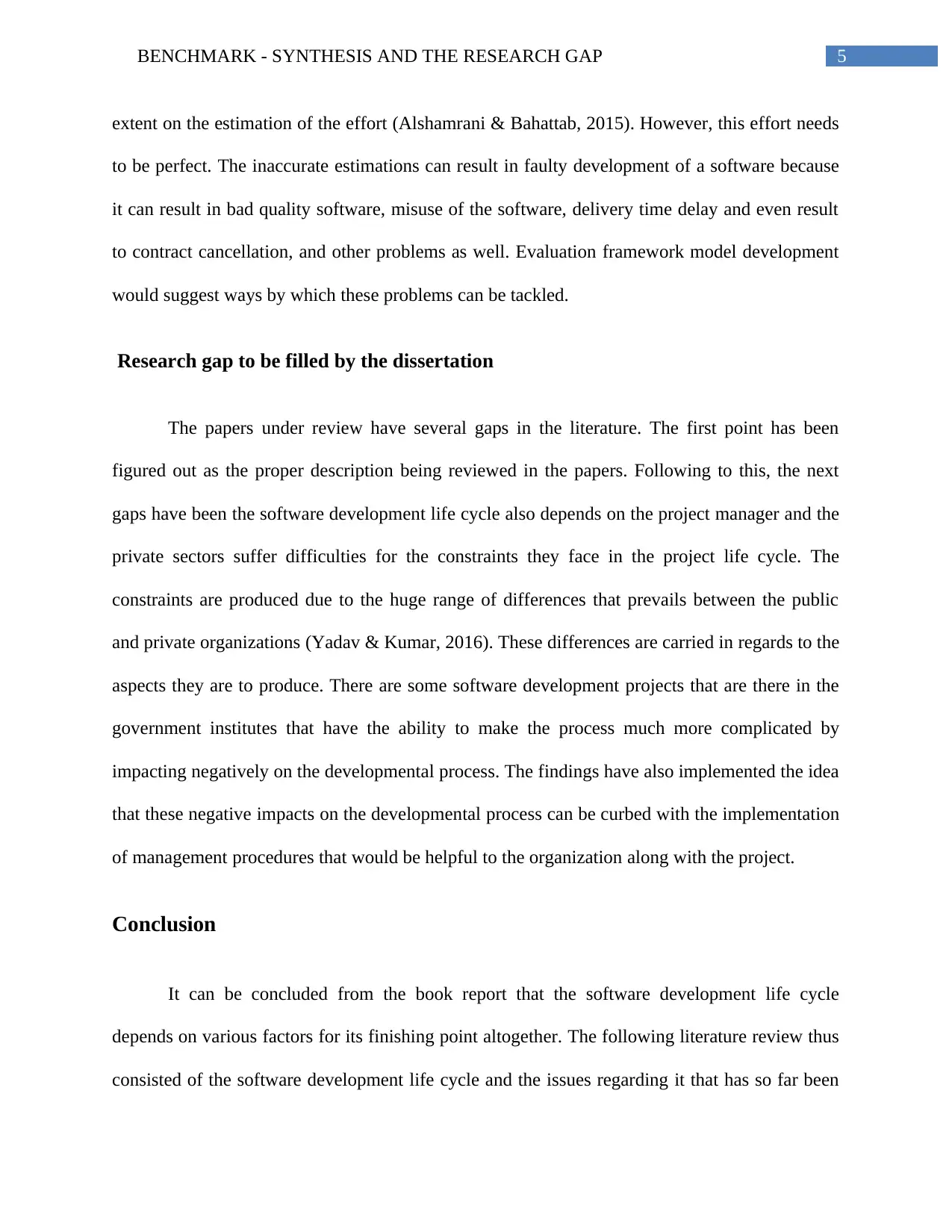
5BENCHMARK - SYNTHESIS AND THE RESEARCH GAP
extent on the estimation of the effort (Alshamrani & Bahattab, 2015). However, this effort needs
to be perfect. The inaccurate estimations can result in faulty development of a software because
it can result in bad quality software, misuse of the software, delivery time delay and even result
to contract cancellation, and other problems as well. Evaluation framework model development
would suggest ways by which these problems can be tackled.
Research gap to be filled by the dissertation
The papers under review have several gaps in the literature. The first point has been
figured out as the proper description being reviewed in the papers. Following to this, the next
gaps have been the software development life cycle also depends on the project manager and the
private sectors suffer difficulties for the constraints they face in the project life cycle. The
constraints are produced due to the huge range of differences that prevails between the public
and private organizations (Yadav & Kumar, 2016). These differences are carried in regards to the
aspects they are to produce. There are some software development projects that are there in the
government institutes that have the ability to make the process much more complicated by
impacting negatively on the developmental process. The findings have also implemented the idea
that these negative impacts on the developmental process can be curbed with the implementation
of management procedures that would be helpful to the organization along with the project.
Conclusion
It can be concluded from the book report that the software development life cycle
depends on various factors for its finishing point altogether. The following literature review thus
consisted of the software development life cycle and the issues regarding it that has so far been
extent on the estimation of the effort (Alshamrani & Bahattab, 2015). However, this effort needs
to be perfect. The inaccurate estimations can result in faulty development of a software because
it can result in bad quality software, misuse of the software, delivery time delay and even result
to contract cancellation, and other problems as well. Evaluation framework model development
would suggest ways by which these problems can be tackled.
Research gap to be filled by the dissertation
The papers under review have several gaps in the literature. The first point has been
figured out as the proper description being reviewed in the papers. Following to this, the next
gaps have been the software development life cycle also depends on the project manager and the
private sectors suffer difficulties for the constraints they face in the project life cycle. The
constraints are produced due to the huge range of differences that prevails between the public
and private organizations (Yadav & Kumar, 2016). These differences are carried in regards to the
aspects they are to produce. There are some software development projects that are there in the
government institutes that have the ability to make the process much more complicated by
impacting negatively on the developmental process. The findings have also implemented the idea
that these negative impacts on the developmental process can be curbed with the implementation
of management procedures that would be helpful to the organization along with the project.
Conclusion
It can be concluded from the book report that the software development life cycle
depends on various factors for its finishing point altogether. The following literature review thus
consisted of the software development life cycle and the issues regarding it that has so far been
⊘ This is a preview!⊘
Do you want full access?
Subscribe today to unlock all pages.

Trusted by 1+ million students worldwide
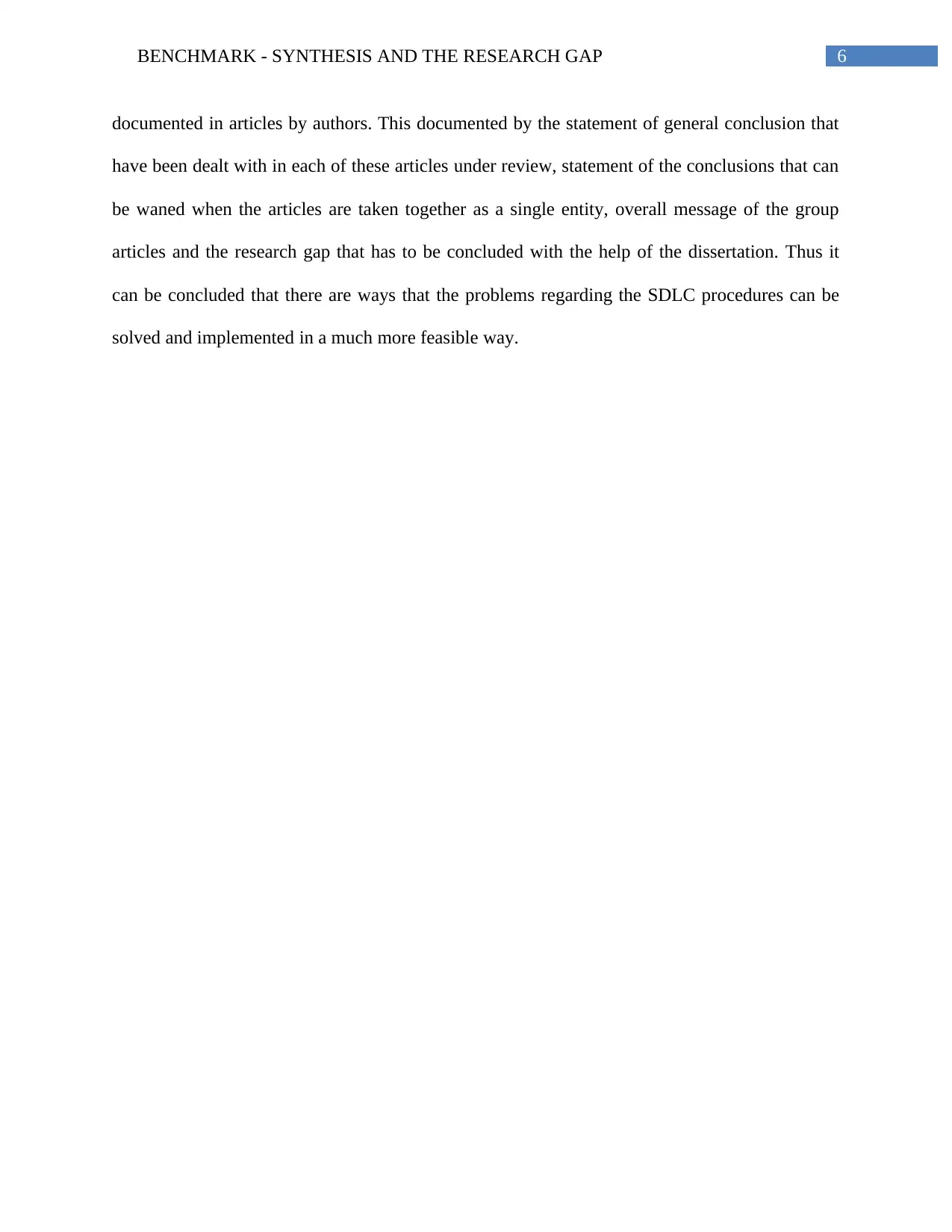
6BENCHMARK - SYNTHESIS AND THE RESEARCH GAP
documented in articles by authors. This documented by the statement of general conclusion that
have been dealt with in each of these articles under review, statement of the conclusions that can
be waned when the articles are taken together as a single entity, overall message of the group
articles and the research gap that has to be concluded with the help of the dissertation. Thus it
can be concluded that there are ways that the problems regarding the SDLC procedures can be
solved and implemented in a much more feasible way.
documented in articles by authors. This documented by the statement of general conclusion that
have been dealt with in each of these articles under review, statement of the conclusions that can
be waned when the articles are taken together as a single entity, overall message of the group
articles and the research gap that has to be concluded with the help of the dissertation. Thus it
can be concluded that there are ways that the problems regarding the SDLC procedures can be
solved and implemented in a much more feasible way.
Paraphrase This Document
Need a fresh take? Get an instant paraphrase of this document with our AI Paraphraser
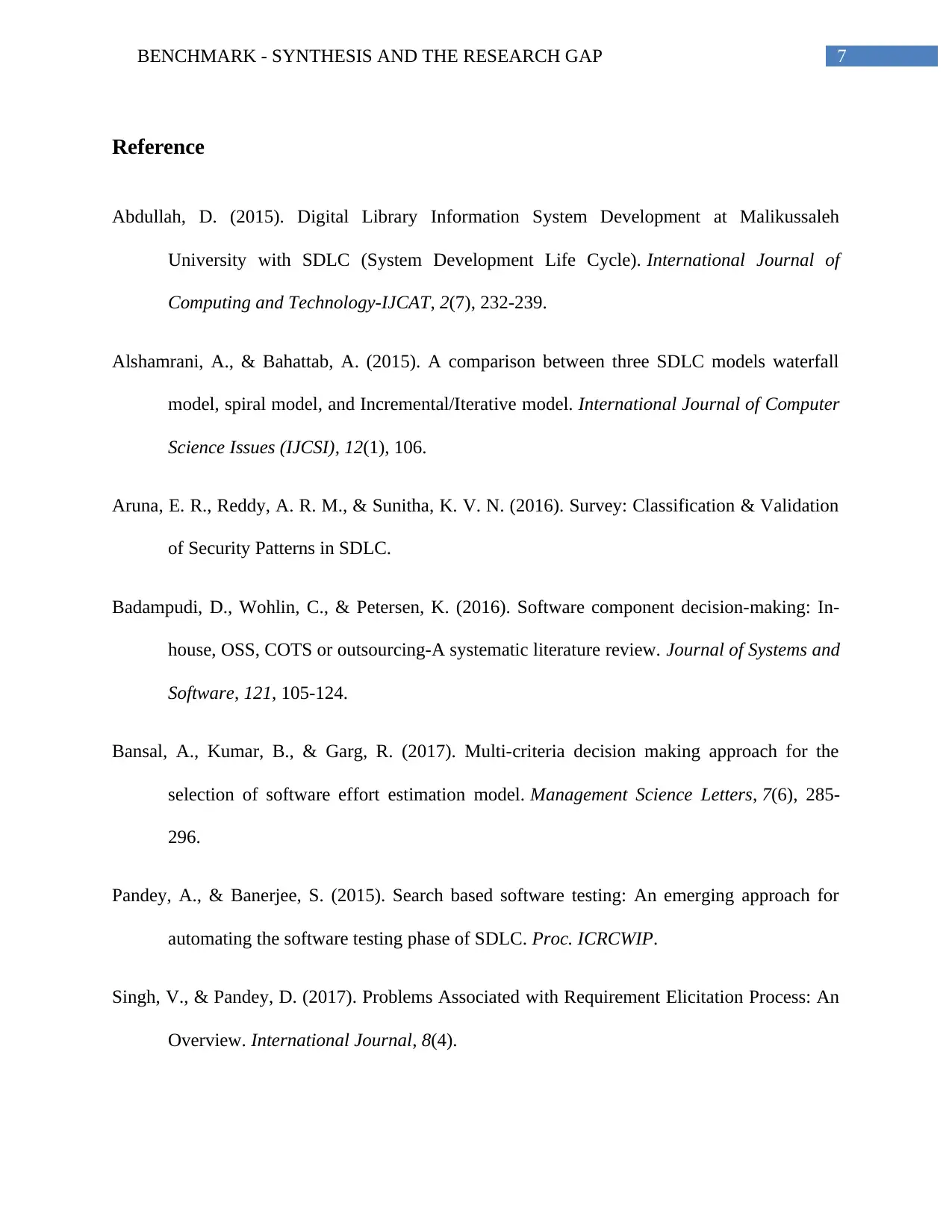
7BENCHMARK - SYNTHESIS AND THE RESEARCH GAP
Reference
Abdullah, D. (2015). Digital Library Information System Development at Malikussaleh
University with SDLC (System Development Life Cycle). International Journal of
Computing and Technology-IJCAT, 2(7), 232-239.
Alshamrani, A., & Bahattab, A. (2015). A comparison between three SDLC models waterfall
model, spiral model, and Incremental/Iterative model. International Journal of Computer
Science Issues (IJCSI), 12(1), 106.
Aruna, E. R., Reddy, A. R. M., & Sunitha, K. V. N. (2016). Survey: Classification & Validation
of Security Patterns in SDLC.
Badampudi, D., Wohlin, C., & Petersen, K. (2016). Software component decision-making: In-
house, OSS, COTS or outsourcing-A systematic literature review. Journal of Systems and
Software, 121, 105-124.
Bansal, A., Kumar, B., & Garg, R. (2017). Multi-criteria decision making approach for the
selection of software effort estimation model. Management Science Letters, 7(6), 285-
296.
Pandey, A., & Banerjee, S. (2015). Search based software testing: An emerging approach for
automating the software testing phase of SDLC. Proc. ICRCWIP.
Singh, V., & Pandey, D. (2017). Problems Associated with Requirement Elicitation Process: An
Overview. International Journal, 8(4).
Reference
Abdullah, D. (2015). Digital Library Information System Development at Malikussaleh
University with SDLC (System Development Life Cycle). International Journal of
Computing and Technology-IJCAT, 2(7), 232-239.
Alshamrani, A., & Bahattab, A. (2015). A comparison between three SDLC models waterfall
model, spiral model, and Incremental/Iterative model. International Journal of Computer
Science Issues (IJCSI), 12(1), 106.
Aruna, E. R., Reddy, A. R. M., & Sunitha, K. V. N. (2016). Survey: Classification & Validation
of Security Patterns in SDLC.
Badampudi, D., Wohlin, C., & Petersen, K. (2016). Software component decision-making: In-
house, OSS, COTS or outsourcing-A systematic literature review. Journal of Systems and
Software, 121, 105-124.
Bansal, A., Kumar, B., & Garg, R. (2017). Multi-criteria decision making approach for the
selection of software effort estimation model. Management Science Letters, 7(6), 285-
296.
Pandey, A., & Banerjee, S. (2015). Search based software testing: An emerging approach for
automating the software testing phase of SDLC. Proc. ICRCWIP.
Singh, V., & Pandey, D. (2017). Problems Associated with Requirement Elicitation Process: An
Overview. International Journal, 8(4).
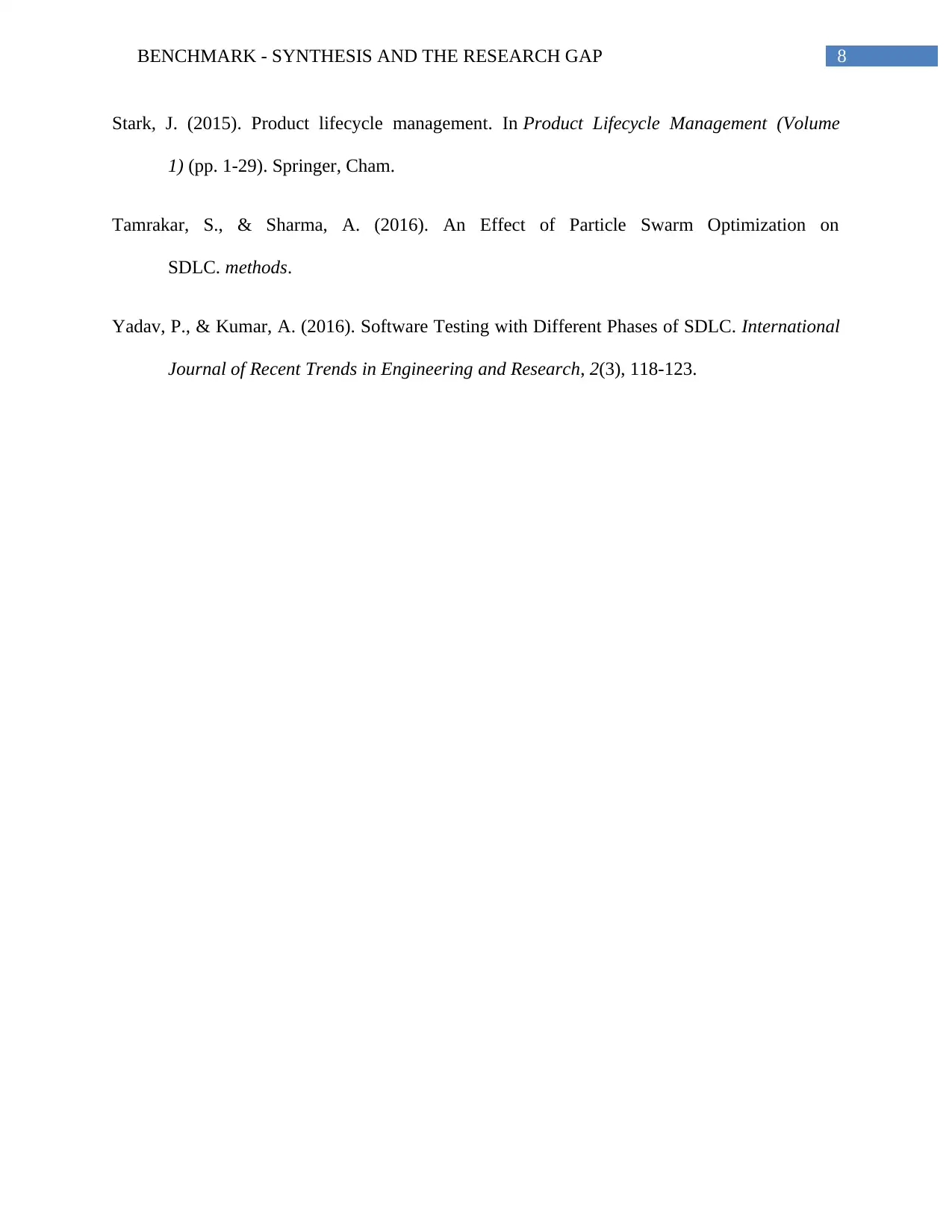
8BENCHMARK - SYNTHESIS AND THE RESEARCH GAP
Stark, J. (2015). Product lifecycle management. In Product Lifecycle Management (Volume
1) (pp. 1-29). Springer, Cham.
Tamrakar, S., & Sharma, A. (2016). An Effect of Particle Swarm Optimization on
SDLC. methods.
Yadav, P., & Kumar, A. (2016). Software Testing with Different Phases of SDLC. International
Journal of Recent Trends in Engineering and Research, 2(3), 118-123.
Stark, J. (2015). Product lifecycle management. In Product Lifecycle Management (Volume
1) (pp. 1-29). Springer, Cham.
Tamrakar, S., & Sharma, A. (2016). An Effect of Particle Swarm Optimization on
SDLC. methods.
Yadav, P., & Kumar, A. (2016). Software Testing with Different Phases of SDLC. International
Journal of Recent Trends in Engineering and Research, 2(3), 118-123.
⊘ This is a preview!⊘
Do you want full access?
Subscribe today to unlock all pages.

Trusted by 1+ million students worldwide
1 out of 9
Related Documents
Your All-in-One AI-Powered Toolkit for Academic Success.
+13062052269
info@desklib.com
Available 24*7 on WhatsApp / Email
![[object Object]](/_next/static/media/star-bottom.7253800d.svg)
Unlock your academic potential
Copyright © 2020–2025 A2Z Services. All Rights Reserved. Developed and managed by ZUCOL.


